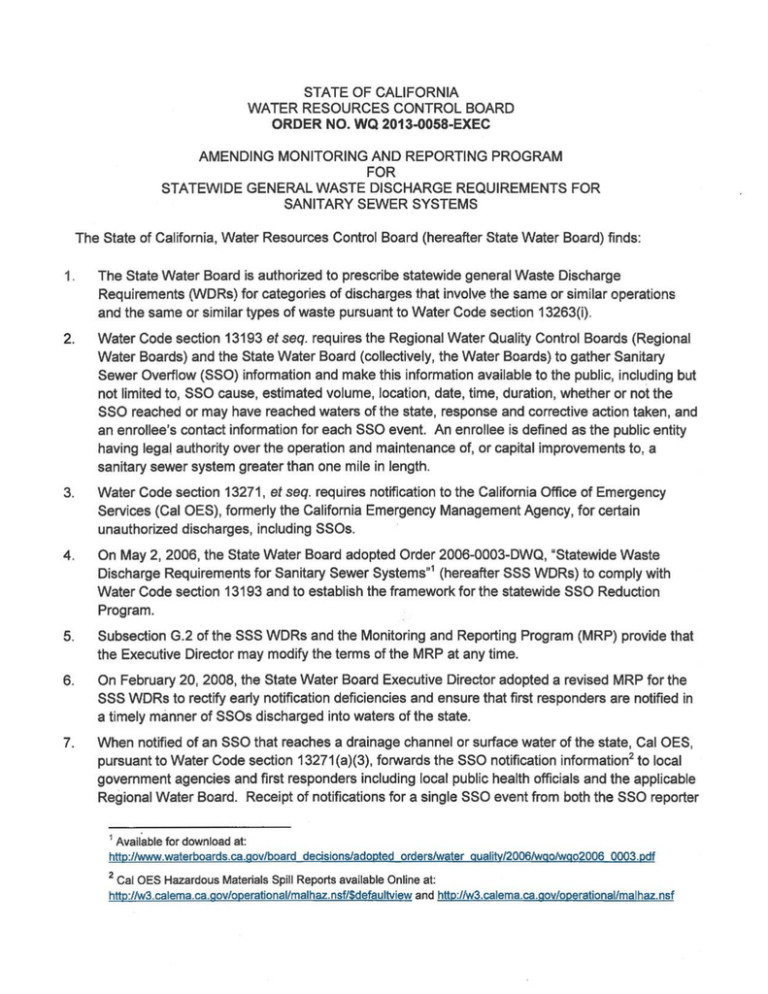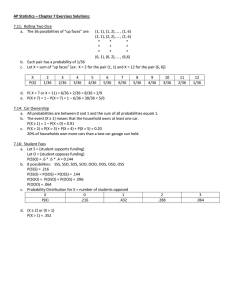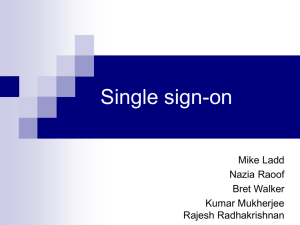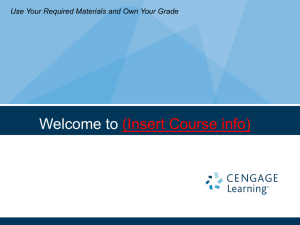Document 12122196
advertisement

ATTACHMENT A STATE WATER RESOURCES CONTROL BOARD ORDER NO. WQ 2013-0058-EXEC AMENDING MONITORING AND REPORTING PROGRAM FOR STATEWIDE GENERAL WASTE DISCHARGE REQUIREMENTS FOR SANITARY SEWER SYSTEMS This Monitoring and Reporting Program (MRP) establishes monitoring, record keeping, reporting and public notification requirements for Order 2006-0003-DWQ, “Statewide General Waste Discharge Requirements for Sanitary Sewer Systems” (SSS WDRs). This MRP shall be effective from September 9, 2013 until it is rescinded. The Executive Director may make revisions to this MRP at any time. These revisions may include a reduction or increase in the monitoring and reporting requirements. All site specific records and data developed pursuant to the SSS WDRs and this MRP shall be complete, accurate, and justified by evidence maintained by the enrollee. Failure to comply with this MRP may subject an enrollee to civil liabilities of up to $5,000 a day per violation pursuant to Water Code section 13350; up to $1,000 a day per violation pursuant to Water Code section 13268; or referral to the Attorney General for judicial civil enforcement. The State Water Resources Control Board (State Water Board) reserves the right to take any further enforcement action authorized by law. A. SUMMARY OF MRP REQUIREMENTS Table 1 – Spill Categories and Definitions CATEGORIES CATEGORY 1 DEFINITIONS [see Section A on page 5 of Order 2006-0003-DWQ, for Sanitary Sewer Overflow (SSO) definition] Discharges of untreated or partially treated wastewater of any volume resulting from an enrollee’s sanitary sewer system failure or flow condition that: x Reach surface water and/or reach a drainage channel tributary to a surface water; or x Reach a Municipal Separate Storm Sewer System (MS4) and are not fully captured and returned to the sanitary sewer system or not otherwise captured and disposed of properly. Any volume of wastewater not recovered from the MS4 is considered to have reached surface water unless the storm drain system discharges to a dedicated storm water or groundwater infiltration basin (e.g., infiltration pit, percolation pond). CATEGORY 2 Discharges of untreated or partially treated wastewater of 1,000 gallons or greater resulting from an enrollee’s sanitary sewer system failure or flow condition that do not reach surface water, a drainage channel, or a MS4 unless the entire SSO discharged to the storm drain system is fully recovered and disposed of properly. CATEGORY 3 All other discharges of untreated or partially treated wastewater resulting from an enrollee’s sanitary sewer system failure or flow condition. PRIVATE LATERAL SEWAGE DISCHARGE (PLSD) Discharges of untreated or partially treated wastewater resulting from blockages or other problems within a privately owned sewer lateral connected to the enrollee’s sanitary sewer system or from other private sewer assets. PLSDs that the enrollee becomes aware of may be voluntarily reported to the California Integrated Water Quality System (CIWQS) Online SSO Database. Monitoring and Reporting Program Order No. WQ 2013-0058-EXEC Statewide Waste Discharge Requirements for Sanitary Sewer Systems Page 2 of 11 Table 2 – Notification, Reporting, Monitoring, and Record Keeping Requirements ELEMENT NOTIFICATION (see section B of MRP) REPORTING (see section C of MRP) REQUIREMENT METHOD x Within two hours of becoming aware of any Category 1 SSO greater than or equal to 1,000 gallons discharged to surface water or spilled in a location where it probably will be discharged to surface water, notify the California Office of Emergency Services (Cal OES) and obtain a notification control number. Call Cal OES at: (800) 852-7550 x Category 1 SSO: Submit draft report within three business days of becoming aware of the SSO and certify within 15 calendar days of SSO end date. Enter data into the CIWQS Online SSO Database (http://ciwqs.waterboards.ca.gov/), certified by enrollee’s Legally Responsible Official(s). x Category 2 SSO: Submit draft report within 3 business days of becoming aware of the SSO and certify within 15 calendar days of the SSO end date. x Category 3 SSO: Submit certified report within 30 calendar days of the end of month in which SSO the occurred. x SSO Technical Report: Submit within 45 calendar days after the end date of any Category 1 SSO in which 50,000 gallons or greater are spilled to surface waters. x “No Spill” Certification: Certify that no SSOs occurred within 30 calendar days of the end of the month or, if reporting quarterly, the quarter in which no SSOs occurred. x Collection System Questionnaire: Update and certify every 12 months. WATER QUALITY MONITORING (see section D of MRP) RECORD KEEPING (see section E of MRP) x Conduct water quality sampling within 48 hours after initial SSO notification for Category 1 SSOs in which 50,000 gallons or greater are spilled to surface waters. Water quality results are required to be uploaded into CIWQS for Category 1 SSOs in which 50,000 gallons or greater are spilled to surface waters. x SSO event records. Self-maintained records shall be available during inspections or upon request. x Records documenting Sanitary Sewer Management Plan (SSMP) implementation and changes/updates to the SSMP. x Records to document Water Quality Monitoring for SSOs of 50,000 gallons or greater spilled to surface waters. x Collection system telemetry records if relied upon to document and/or estimate SSO Volume. Monitoring and Reporting Program Order No. WQ 2013-0058-EXEC Statewide Waste Discharge Requirements for Sanitary Sewer Systems B. Page 3 of 11 NOTIFICATION REQUIREMENTS Although Regional Water Quality Control Boards (Regional Water Boards) and the State Water Board (collectively, the Water Boards) staff do not have duties as first responders, this MRP is an appropriate mechanism to ensure that the agencies that have first responder duties are notified in a timely manner in order to protect public health and beneficial uses. 1. For any Category 1 SSO greater than or equal to 1,000 gallons that results in a discharge to a surface water or spilled in a location where it probably will be discharged to surface water, either directly or by way of a drainage channel or MS4, the enrollee shall, as soon as possible, but not later than two (2) hours after (A) the enrollee has knowledge of the discharge, (B) notification is possible, and (C) notification can be provided without substantially impeding cleanup or other emergency measures, notify the Cal OES and obtain a notification control number. 2. To satisfy notification requirements for each applicable SSO, the enrollee shall provide the information requested by Cal OES before receiving a control number. Spill information requested by Cal OES may include: i. Name of person notifying Cal OES and direct return phone number. ii. Estimated SSO volume discharged (gallons). iii. If ongoing, estimated SSO discharge rate (gallons per minute). iv. SSO Incident Description: a. Brief narrative. b. On-scene point of contact for additional information (name and cell phone number). c. Date and time enrollee became aware of the SSO. d. Name of sanitary sewer system agency causing the SSO. e. SSO cause (if known). v. Indication of whether the SSO has been contained. vi. Indication of whether surface water is impacted. vii. Name of surface water impacted by the SSO, if applicable. viii. Indication of whether a drinking water supply is or may be impacted by the SSO. ix. Any other known SSO impacts. x. SSO incident location (address, city, state, and zip code). 3. Following the initial notification to Cal OES and until such time that an enrollee certifies the SSO report in the CIWQS Online SSO Database, the enrollee shall provide updates to Cal OES regarding substantial changes to the estimated volume of untreated or partially treated sewage discharged and any substantial change(s) to known impact(s). 4. PLSDs: The enrollee is strongly encouraged to notify Cal OES of discharges greater than or equal to 1,000 gallons of untreated or partially treated wastewater that result or may result in a discharge to surface water resulting from failures or flow conditions within a privately owned sewer lateral or from other private sewer asset(s) if the enrollee becomes aware of the PLSD. Monitoring and Reporting Program Order No. WQ 2013-0058-EXEC Statewide Waste Discharge Requirements for Sanitary Sewer Systems C. Page 4 of 11 REPORTING REQUIREMENTS 1. CIWQS Online SSO Database Account: All enrollees shall obtain a CIWQS Online SSO Database account and receive a “Username” and “Password” by registering through CIWQS. These accounts allow controlled and secure entry into the CIWQS Online SSO Database. 2. SSO Mandatory Reporting Information: For reporting purposes, if one SSO event results in multiple appearance points in a sewer system asset, the enrollee shall complete one SSO report in the CIWQS Online SSO Database which includes the GPS coordinates for the location of the SSO appearance point closest to the failure point, blockage or location of the flow condition that caused the SSO, and provide descriptions of the locations of all other discharge points associated with the SSO event. 3. SSO Categories i. Category 1 – Discharges of untreated or partially treated wastewater of any volume resulting from an enrollee’s sanitary sewer system failure or flow condition that: a. Reach surface water and/or reach a drainage channel tributary to a surface water; or b. Reach a MS4 and are not fully captured and returned to the sanitary sewer system or not otherwise captured and disposed of properly. Any volume of wastewater not recovered from the MS4 is considered to have reached surface water unless the storm drain system discharges to a dedicated storm water or groundwater infiltration basin (e.g., infiltration pit, percolation pond). ii. Category 2 – Discharges of untreated or partially treated wastewater greater than or equal to 1,000 gallons resulting from an enrollee’s sanitary sewer system failure or flow condition that does not reach a surface water, a drainage channel, or the MS4 unless the entire SSO volume discharged to the storm drain system is fully recovered and disposed of properly. iii. Category 3 – All other discharges of untreated or partially treated wastewater resulting from an enrollee’s sanitary sewer system failure or flow condition. 4. Sanitary Sewer Overflow Reporting to CIWQS - Timeframes i. Category 1 and Category 2 SSOs – All SSOs that meet the above criteria for Category 1 or Category 2 SSOs shall be reported to the CIWQS Online SSO Database: a. Draft reports for Category 1 and Category 2 SSOs shall be submitted to the CIWQS Online SSO Database within three (3) business days of the enrollee becoming aware of the SSO. Minimum information that shall be reported in a draft Category 1 SSO report shall include all information identified in section 8.i.a. below. Minimum information that shall be reported in a Category 2 SSO draft report shall include all information identified in section 8.i.c below. b. A final Category 1 or Category 2 SSO report shall be certified through the CIWQS Online SSO Database within 15 calendar days of the end date of the SSO. Minimum information that shall be certified in the final Category 1 SSO report shall include all information identified in section 8.i.b below. Minimum information that shall be certified in a final Category 2 SSO report shall include all information identified in section 8.i.d below. Monitoring and Reporting Program Order No. WQ 2013-0058-EXEC Statewide Waste Discharge Requirements for Sanitary Sewer Systems Page 5 of 11 ii. Category 3 SSOs – All SSOs that meet the above criteria for Category 3 SSOs shall be reported to the CIWQS Online SSO Database and certified within 30 calendar days after the end of the calendar month in which the SSO occurs (e.g., all Category 3 SSOs occurring in the month of February shall be entered into the database and certified by March 30). Minimum information that shall be certified in a final Category 3 SSO report shall include all information identified in section 8.i.e below. iii. “No Spill” Certification – If there are no SSOs during the calendar month, the enrollee shall either 1) certify, within 30 calendar days after the end of each calendar month, a “No Spill” certification statement in the CIWQS Online SSO Database certifying that there were no SSOs for the designated month, or 2) certify, quarterly within 30 calendar days after the end of each quarter, “No Spill” certification statements in the CIWQS Online SSO Database certifying that there were no SSOs for each month in the quarter being reported on. For quarterly reporting, the quarters are Q1 - January/ February/ March, Q2 April/May/June, Q3 - July/August/September, and Q4 - October/November/December. If there are no SSOs during a calendar month but the enrollee reported a PLSD, the enrollee shall still certify a “No Spill” certification statement for that month. iv. Amended SSO Reports – The enrollee may update or add additional information to a certified SSO report within 120 calendar days after the SSO end date by amending the report or by adding an attachment to the SSO report in the CIWQS Online SSO Database. SSO reports certified in the CIWQS Online SSO Database prior to the adoption date of this MRP may only be amended up to 120 days after the effective date of this MRP. After 120 days, the enrollee may contact the SSO Program Manager to request to amend an SSO report if the enrollee also submits justification for why the additional information was not available prior to the end of the 120 days. 5. SSO Technical Report The enrollee shall submit an SSO Technical Report in the CIWQS Online SSO Database within 45 calendar days of the SSO end date for any SSO in which 50,000 gallons or greater are spilled to surface waters. This report, which does not preclude the Water Boards from requiring more detailed analyses if requested, shall include at a minimum, the following: i. Causes and Circumstances of the SSO: a. Complete and detailed explanation of how and when the SSO was discovered. b. Diagram showing the SSO failure point, appearance point(s), and final destination(s). c. Detailed description of the methodology employed and available data used to calculate the volume of the SSO and, if applicable, the SSO volume recovered. d. Detailed description of the cause(s) of the SSO. e. Copies of original field crew records used to document the SSO. f. Historical maintenance records for the failure location. ii. Enrollee’s Response to SSO: a. Chronological narrative description of all actions taken by enrollee to terminate the spill. b. Explanation of how the SSMP Overflow Emergency Response plan was implemented to respond to and mitigate the SSO. Monitoring and Reporting Program Order No. WQ 2013-0058-EXEC Statewide Waste Discharge Requirements for Sanitary Sewer Systems c. Page 6 of 11 Final corrective action(s) completed and/or planned to be completed, including a schedule for actions not yet completed. iii. Water Quality Monitoring: a. Description of all water quality sampling activities conducted including analytical results and evaluation of the results. b. Detailed location map illustrating all water quality sampling points. 6. PLSDs Discharges of untreated or partially treated wastewater resulting from blockages or other problems within a privately owned sewer lateral connected to the enrollee’s sanitary sewer system or from other private sanitary sewer system assets may be voluntarily reported to the CIWQS Online SSO Database. i. The enrollee is also encouraged to provide notification to Cal OES per section B above when a PLSD greater than or equal to 1,000 gallons has or may result in a discharge to surface water. For any PLSD greater than or equal to 1,000 gallons regardless of the spill destination, the enrollee is also encouraged to file a spill report as required by Health and Safety Code section 5410 et. seq. and Water Code section 13271, or notify the responsible party that notification and reporting should be completed as specified above and required by State law. ii. If a PLSD is recorded in the CIWQS Online SSO Database, the enrollee must identify the sewage discharge as occurring and caused by a private sanitary sewer system asset and should identify a responsible party (other than the enrollee), if known. Certification of PLSD reports by enrollees is not required. 7. CIWQS Online SSO Database Unavailability In the event that the CIWQS Online SSO Database is not available, the enrollee must fax or e-mail all required information to the appropriate Regional Water Board office in accordance with the time schedules identified herein. In such event, the enrollee must also enter all required information into the CIWQS Online SSO Database when the database becomes available. 8. Mandatory Information to be Included in CIWQS Online SSO Reporting All enrollees shall obtain a CIWQS Online SSO Database account and receive a “Username” and “Password” by registering through CIWQS which can be reached at CIWQS@waterboards.ca.gov or by calling (866) 792-4977, M-F, 8 A.M. to 5 P.M. These accounts will allow controlled and secure entry into the CIWQS Online SSO Database. Additionally, within thirty (30) days of initial enrollment and prior to recording SSOs into the CIWQS Online SSO Database, all enrollees must complete a Collection System Questionnaire (Questionnaire). The Questionnaire shall be updated at least once every 12 months. i. SSO Reports At a minimum, the following mandatory information shall be reported prior to finalizing and certifying an SSO report for each category of SSO: Monitoring and Reporting Program Order No. WQ 2013-0058-EXEC Statewide Waste Discharge Requirements for Sanitary Sewer Systems a. Page 7 of 11 Draft Category 1 SSOs: At a minimum, the following mandatory information shall be reported for a draft Category 1 SSO report: 1. SSO Contact Information: Name and telephone number of enrollee contact person who can answer specific questions about the SSO being reported. 2. SSO Location Name. 3. Location of the overflow event (SSO) by entering GPS coordinates. If a single overflow event results in multiple appearance points, provide GPS coordinates for the appearance point closest to the failure point and describe each additional appearance point in the SSO appearance point explanation field. 4. Whether or not the SSO reached surface water, a drainage channel, or entered and was discharged from a drainage structure. 5. Whether or not the SSO reached a municipal separate storm drain system. 6. Whether or not the total SSO volume that reached a municipal separate storm drain system was fully recovered. 7. Estimate of the SSO volume, inclusive of all discharge point(s). 8. Estimate of the SSO volume that reached surface water, a drainage channel, or was not recovered from a storm drain. 9. Estimate of the SSO volume recovered (if applicable). 10. Number of SSO appearance point(s). 11. Description and location of SSO appearance point(s). If a single sanitary sewer system failure results in multiple SSO appearance points, each appearance point must be described. 12. SSO start date and time. 13. Date and time the enrollee was notified of, or self-discovered, the SSO. 14. Estimated operator arrival time. 15. For spills greater than or equal to 1,000 gallons, the date and time Cal OES was called. 16. For spills greater than or equal to 1,000 gallons, the Cal OES control number. b. Certified Category 1 SSOs: At a minimum, the following mandatory information shall be reported for a certified Category 1 SSO report, in addition to all fields in section 8.i.a : 1. 2. 3. 4. 5. 6. Description of SSO destination(s). SSO end date and time. SSO causes (mainline blockage, roots, etc.). SSO failure point (main, lateral, etc.). Whether or not the spill was associated with a storm event. Description of spill corrective action, including steps planned or taken to reduce, eliminate, and prevent reoccurrence of the overflow; and a schedule of major milestones for those steps. 7. Description of spill response activities. 8. Spill response completion date. 9. Whether or not there is an ongoing investigation, the reasons for the investigation and the expected date of completion. Monitoring and Reporting Program Order No. WQ 2013-0058-EXEC Statewide Waste Discharge Requirements for Sanitary Sewer Systems Page 8 of 11 10. Whether or not a beach closure occurred or may have occurred as a result of the SSO. 11. Whether or not health warnings were posted as a result of the SSO. 12. Name of beach(es) closed and/or impacted. If no beach was impacted, NA shall be selected. 13. Name of surface water(s) impacted. 14. If water quality samples were collected, identify parameters the water quality samples were analyzed for. If no samples were taken, NA shall be selected. 15. If water quality samples were taken, identify which regulatory agencies received sample results (if applicable). If no samples were taken, NA shall be selected. 16. Description of methodology(ies) and type of data relied upon for estimations of the SSO volume discharged and recovered. 17. SSO Certification: Upon SSO Certification, the CIWQS Online SSO Database will issue a final SSO identification (ID) number. c. Draft Category 2 SSOs: At a minimum, the following mandatory information shall be reported for a draft Category 2 SSO report: 1. Items 1-14 in section 8.i.a above for Draft Category 1 SSO. d. Certified Category 2 SSOs: At a minimum, the following mandatory information shall be reported for a certified Category 2 SSO report: 1. Items 1-14 in section 8.i.a above for Draft Category 1 SSO and Items 1-9, and 17 in section 8.i.b above for Certified Category 1 SSO. e. Certified Category 3 SSOs: At a minimum, the following mandatory information shall be reported for a certified Category 3 SSO report: 1. Items 1-14 in section 8.i.a above for Draft Category 1 SSO and Items 1-5, and 17 in section 8.i.b above for Certified Category 1 SSO. ii. Reporting SSOs to Other Regulatory Agencies These reporting requirements do not preclude an enrollee from reporting SSOs to other regulatory agencies pursuant to state law. In addition, these reporting requirements do not replace other Regional Water Board notification and reporting requirements for SSOs. iii. Collection System Questionnaire The required Questionnaire (see subsection G of the SSS WDRs) provides the Water Boards with site-specific information related to the enrollee’s sanitary sewer system. The enrollee shall complete and certify the Questionnaire at least every 12 months to facilitate program implementation, compliance assessment, and enforcement response. iv. SSMP Availability The enrollee shall provide the publicly available internet web site address to the CIWQS Online SSO Database where a downloadable copy of the enrollee’s approved SSMP, critical supporting documents referenced in the SSMP, and proof of local governing board approval of the SSMP is posted. If all of the SSMP documentation listed in this subsection is not publicly available on the Internet, the enrollee shall comply with the following procedure: Monitoring and Reporting Program Order No. WQ 2013-0058-EXEC Statewide Waste Discharge Requirements for Sanitary Sewer Systems a. Page 9 of 11 Submit an electronic copy of the enrollee’s approved SSMP, critical supporting documents referenced in the SSMP, and proof of local governing board approval of the SSMP to the State Water Board, within 30 days of that approval and within 30 days of any subsequent SSMP re-certifications, to the following mailing address: State Water Resources Control Board Division of Water Quality Attn: SSO Program Manager 1001 I Street, 15th Floor, Sacramento, CA 95814 D. WATER QUALITY MONITORING REQUIREMENTS: To comply with subsection D.7(v) of the SSS WDRs, the enrollee shall develop and implement an SSO Water Quality Monitoring Program to assess impacts from SSOs to surface waters in which 50,000 gallons or greater are spilled to surface waters. The SSO Water Quality Monitoring Program, shall, at a minimum: 1. Contain protocols for water quality monitoring. 2. Account for spill travel time in the surface water and scenarios where monitoring may not be possible (e.g. safety, access restrictions, etc.). 3. Require water quality analyses for ammonia and bacterial indicators to be performed by an accredited or certified laboratory. 4. Require monitoring instruments and devices used to implement the SSO Water Quality Monitoring Program to be properly maintained and calibrated, including any records to document maintenance and calibration, as necessary, to ensure their continued accuracy. 5. Within 48 hours of the enrollee becoming aware of the SSO, require water quality sampling for, at a minimum, the following constituents: i. Ammonia ii. Appropriate Bacterial indicator(s) per the applicable Basin Plan water quality objective or Regional Board direction which may include total and fecal coliform, enterococcus, and e-coli. E. RECORD KEEPING REQUIREMENTS: The following records shall be maintained by the enrollee for a minimum of five (5) years and shall be made available for review by the Water Boards during an onsite inspection or through an information request: 1. General Records: The enrollee shall maintain records to document compliance with all provisions of the SSS WDRs and this MRP for each sanitary sewer system owned including any required records generated by an enrollee’s sanitary sewer system contractor(s). 2. SSO Records: The enrollee shall maintain records for each SSO event, including but not limited to: i. Complaint records documenting how the enrollee responded to all notifications of possible or actual SSOs, both during and after business hours, including complaints that do not Monitoring and Reporting Program Order No. WQ 2013-0058-EXEC Statewide Waste Discharge Requirements for Sanitary Sewer Systems Page 10 of 11 result in SSOs. Each complaint record shall, at a minimum, include the following information: a. Date, time, and method of notification. b. Date and time the complainant or informant first noticed the SSO. c. Narrative description of the complaint, including any information the caller can provide regarding whether or not the complainant or informant reporting the potential SSO knows if the SSO has reached surface waters, drainage channels or storm drains. d. Follow-up return contact information for complainant or informant for each complaint received, if not reported anonymously. e. Final resolution of the complaint. ii. Records documenting steps and/or remedial actions undertaken by enrollee, using all available information, to comply with section D.7 of the SSS WDRs. iii. Records documenting how all estimate(s) of volume(s) discharged and, if applicable, volume(s) recovered were calculated. 3. Records documenting all changes made to the SSMP since its last certification indicating when a subsection(s) of the SSMP was changed and/or updated and who authorized the change or update. These records shall be attached to the SSMP. 4. Electronic monitoring records relied upon for documenting SSO events and/or estimating the SSO volume discharged, including, but not limited to records from: i. Supervisory Control and Data Acquisition (SCADA) systems ii. Alarm system(s) iii. Flow monitoring device(s) or other instrument(s) used to estimate wastewater levels, flow rates and/or volumes. F. CERTIFICATION 1. All information required to be reported into the CIWQS Online SSO Database shall be certified by a person designated as described in subsection J of the SSS WDRs. This designated person is also known as a Legally Responsible Official (LRO). An enrollee may have more than one LRO. 2. Any designated person (i.e. an LRO) shall be registered with the State Water Board to certify reports in accordance with the CIWQS protocols for reporting. 3. Data Submitter (DS): Any enrollee employee or contractor may enter draft data into the CIWQS Online SSO Database on behalf of the enrollee if authorized by the LRO and registered with the State Water Board. However, only LROs may certify reports in CIWQS. 4. The enrollee shall maintain continuous coverage by an LRO. Any change of a registered LRO or DS (e.g., retired staff), including deactivation or a change to the LRO’s or DS’s contact information, shall be submitted by the enrollee to the State Water Board within 30 days of the change by calling (866) 792-4977 or e-mailing help@ciwqs.waterboards.ca.gov.




